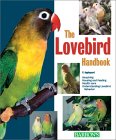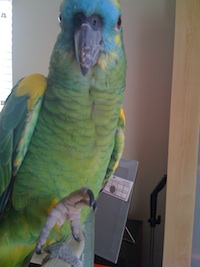Up! Up! Teaching the Step Up Command
If there is one thing you can train your parrot to do that will improve and help maintain your relationship, it is to step up on command. This can be done with a simple verbal command like “Step up,” or as I use with my birds, “Up, Up!” The command should be used whenever you pick up your bird as it is a very simple and clear way to establish dominance in a gentle way. My amazon parrot now says “Up, Up” when she wants me to pick her up!
The most important time to use the step up command is when removing your bird from his cage or from his playstand. If you let your bird just crawl out of his cage on his own, you lose a very important opportunity to establish the line of command. By using the step up command, you can often avoid the tricky issue of cage territoriality. Birds who develop cage territoriality will snap at you when you reach into the cage or simply refuse to come out. This causes owners to become reluctant to put their hand into the cage, thus creating a situation where the bird rules the roost.
If such problems already exist, you may be “hand shy” at this point: you pull your hand away as soon as you see the beak head down. A few good parrot bites can make anyone afraid to stick their hand in the piranha’s den. However, birds also use their beaks like a third hand to help them balance. Pulling your hand away gives them the message that you are an unreliable perch.
In such cases it is best to stick train your bird first. That is, you train the bird using the up command, but you train them to step up on a long stick rather than on your hand. This allows you to avoid giving mixed messages, which is what happens when you pull your hand away after giving the up command because you fear being bitten. Gently press the stick against the bird’s chest the same way you would your hand. Firmly give the up command and push gently until the bird has to step up to avoid falling off the perch. There is no need to use much pressure, as a bird will generally step up as soon as it feels itself leaning back off the perch, but be very direct and clear with this method. If you let the bird run off and start to chase it with the stick, you are sabotaging the very thing you are trying to establish: gentle dominance.
Certain species have a reputation for becoming aggressive during the Spring or when hormones are raging, amazon parrots in particular. It is highly recommended that you stick train an amazon and keep up this training throughout its early years so that it will be comfortable with stepping up on the stick when it reaches maturity.
Remember that this training is not just for large parrots. Small parrots such as lovebirds need this sort of gentle dominance as well. Teaching a lovebird to step up when it is a baby is one of the best ways to prevent future behavioral problems.
Once your bird steps up on the stick on command, you can start to train your bird to step up on command onto your hand. Do this away from the cage at first. It is a good idea to have a simple training t-stand for this. Set the bird on the perch, look it straight in the eye, then put your hand against its chest and press gently while saying, “Step up!” You can occasionally give your bird a treat for obeying the up command, but don’t give a treat every time. Simple praise is an excellent way to reinforce good behavior. Most parrot owners know that their birds just love it when they gush!










